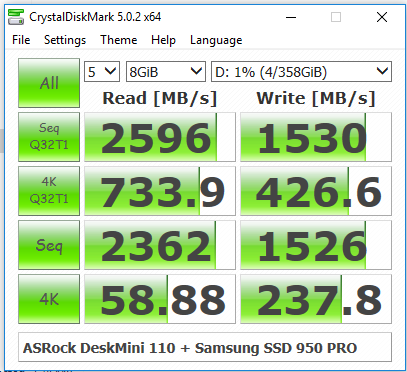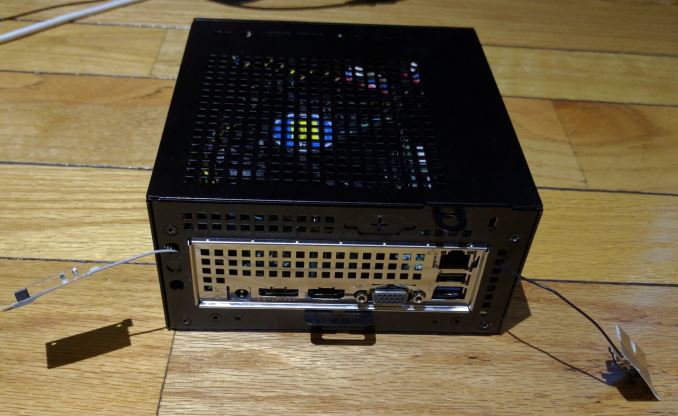ASRock DeskMini 110 mini-STX PC Review
by Ganesh T S on June 8, 2016 8:45 AM ESTNetworking and Storage Performance
Networking and storage are two major aspects which influence our experience with any computing system. This section presents results from our evaluation of these aspects in the ASRock DeskMini 110. On the storage side, one option would be repetition of our strenuous SSD review tests on the drive(s) in the PC. Fortunately, to avoid that overkill, PCMark 8 has a storage bench where certain common workloads such as loading games and document processing are replayed on the target drive. Results are presented in two forms, one being a benchmark number and the other, a bandwidth figure. We ran the PCMark 8 storage bench on selected PCs and the results are presented below.


Despite using the same SSD, we do see some difference in scores between Skull Canyon and the DeskMini. This probably results from differences in the CPU capabilities, since the storage bandwidth actually reflects the amount of time that the CPU was waiting on at least one I/O request to the disk.
The important aspect to test from the DeskMini viewpoint is PCIe 3.0 x4 support (since the H110 has only PCIe 2.0 support). We ran the quick CrystalDiskMark check and could see that the Samsung SSD 950 PRO showed its quoted performance numbers.
On the networking side, we restricted ourselves to the evaluation of the WLAN component. Our standard test router is the Netgear R7000 Nighthawk configured with both 2.4 GHz and 5 GHz networks. The router is placed approximately 20 ft. away, separated by a drywall (as in a typical US building). A wired client is connected to the R7000 and serves as one endpoint for iperf evaluation. The PC under test is made to connect to either the 5 GHz (preferred) or 2.4 GHz SSID and iperf tests are conducted for both TCP and UDP transfers. It is ensured that the PC under test is the only wireless client for the Netgear R7000. We evaluate total throughput for up to 32 simultaneous TCP connections using iperf and present the highest number in the graph below.

In the UDP case, we try to transfer data at the highest rate possible for which we get less than 1% packet loss.

Our main aim with the WLAN component was to show that the DeskMini could indeed support a M.2 PCIe WLAN module. Intel actually provided us with a AC8260 card meant for the Skull Canyon NUC. Therefore, the antenna type we got was really not a good fit for the all-metal chassis. We ended up doing the above evaluation with the antennae not mounted to the chassis, but just hanging out of the system. Despite this unwieldy setup, the system had no trouble getting good numbers in our bandwidth test.
The DeskMini chassis does provide three perforations diagonally across the M.2 WLAN slot in the rear to install screw-type antennas. Consumers can keep this in mind while hunting for the appropriate WLAN component to complete a DeskMini build.












85 Comments
View All Comments
r3loaded - Wednesday, June 8, 2016 - link
Yeah, MXM was invented to make life easy for OEMs, not consumers.Flunk - Wednesday, June 8, 2016 - link
I think the ship has sailed on that idea, people want smaller and smaller notebooks, not huge ones with huge upgradability.CharonPDX - Wednesday, June 8, 2016 - link
Heck even a transverse (on a riser, across the top of the CPU,) half-height, short-length PCIe x16 slot would be nice, there are "decent", (although not "super powerful) video cards available for half-height, short-length slots.Valantar - Wednesday, June 8, 2016 - link
Thunderbolt 3 alongside similarly sized (stackable?) (MXM-based) external GPUs would be better. Want a small system with just what you need for office/HTPC duty? Skip the GPU. Want a compact gaming rig? Get the extra chassis and (given proper availability and firmware standardization) whatever MXM GPU you want. You could easily fit the "MXM+" GTX 980 (and thus 1080, whenever it's out) in a 5" by 5" form factor, and cooling would be a breeze with a heatsink filling two dimensions of the chassis fitted with a downward blowing 120mm fan.marc1000 - Thursday, June 9, 2016 - link
MXM has lots of issues.I believe if you wanna go this small, it is better to stick with NUCs. if you need some more power, go for mITX + standard GPU.
Calista - Sunday, June 12, 2016 - link
Problem is a mITX case could easily handle a 1000 watt system, going with a full-sized ATX PSU and a high-end GPU/CPU combo and a large bunch of drives. It would be noisy when going full tilt, but it would be doable. What people seem to be asking for is a <200 watt tiny system with interchangeable parts. A 200 watt TDP would allow for a small but efficient PSU to fit within a small case, a 65W CPU and a 100 watt GPU, meaning even a modern high-end GPU like the GTX 970.The mSTX form factor just sounds like the answer to a question no one has asked.
repoman27 - Friday, June 10, 2016 - link
The switch to HBM and stacking the memory and GPU on interposers will enable socketed GPUs in near future. Hopefully that becomes a thing.Namisecond - Wednesday, July 6, 2016 - link
You'd have the same problems with MXM there as you do with them on laptops, with maybe marginally more volume for a cooling system.MXM was not designed to be a user serviceable interface. The sooner you realize that, the happier you'll be. :3
SeanFL - Wednesday, June 8, 2016 - link
Glad to see more vendors gearing up in the small space PC's. Have changed over to NUC's and other small form factors in the house and at work and they work fantastic for almost everything. The monster 6 core machine (i7-5930k) only gets used for video editing now.blackice85 - Wednesday, June 8, 2016 - link
Agreed, I'm glad that these have become pretty viable now. I'm looking to replace my big PC with a smaller machine as well, but would like to still do some medium-ish quality gaming on occasion. I'm hoping the new AMD Zen APUs next year fit the bill, I'll have to see how they review. It would just be cool if a discrete GPU wasn't really a requirement anymore.